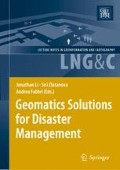Abstract
Maritime traffic analysis is growing in importance for many reasons: risk management, accident prevention and response planning. Since most decisions are location-sensitive, one important consideration in maritime traffic analysis involves maritime risk analysis, including spatial analysis to identify hot spots. Hot spots areas are concentrations of incidents within a limited geographical area that appear over time.
In recent years, information - particularly spatially referenced information - and the tools for information analysis have become increasingly recognized as an essential part of the policy-making and decision- making processes to make the descriptive, explanatory, predictive and risk prevention models.
The increasing power of computing hardware and software and the increasing sophistication of the analytical geomatics techniques mean that new opportunities are available for spatial analysis to improve the quality of risk prevention plans.
Recent studies have shown that geospatial information is of fundamental importance to maritime risk analysis providing efficient risk management and GISs represent a powerful new technology that can address many information needs of risk managers and decision makers working with geographically referenced data.
This study used the increased capabilities offered by Geomatics techniques and geographic information systems to identify hazardous locations for maritime traffic in Canadian Atlantic waters. This research uses spatial analysis to examine risks associated with maritime commercial fishing vessels activities and incidents.
Access this chapter
Tax calculation will be finalised at checkout
Purchases are for personal use only
Preview
Unable to display preview. Download preview PDF.
References
Arlinghaus SL (1996) Practical Handbook of Spatial Statistics. Canadian Coast Guard, Search & Rescue Branch, System of Information for Search and Rescue (SISAR). Ottawa, Canada
Department of Fisheries and Oceans, Scotia Fundy management region, Canada. Zonal Interchange Fisheries (ZIF).
ICF Kaiser Consulating Group, Soza and Company, and Marine Research Associates, (1997). The economic impacts of accidents on the marine industry. Washington, DC, Government Printing Office.
Jin Di, J, Kite-Powell H, Talley W (2001). The safety of commercial fishing: Determinations of vessel total losses and injuries, Journal of Safety Research, Vol. 32, 209–228.
Di J, Kite-Powell H, Talley W, (2002). A model of fishing vessel accident probability, Journal of safety Research, Vol. 33, 497–510
National Research Council (1991) Spatial statistics and digital image analysis panel on spatial statistics and image processing, Board on Mathematical Sciences
Van NM (1995) Toward a systematic approach to safety in the commercial fishing industry, Journal of Safety Research, Vol. 26(1), 19–29.
Pelot R (2002) Maritime Activity and Risk Analysis System, Dalhousie University, Halifax, Nova Scotia, Canada.
Shahrabi J, and Ronald P (2003) Evaluation of hot spot analyses applied to maritime SAR incidents, GEOIDE Annual Conference, Victoria, BC, Canada
Shahrabi J (2003). Spatial and temporal analyses of maritime fishing and shipping traffic and incidents, Ph.D. Thesis, Industrial Engineering Department, Dalhousie University, Halifax, Nova Scotia, Canada.
Sokal RR and Sneath PHA (1963). Principles of numerical taxonomy. W. H. Freeman and Co.: San Francisco.
Systat, Inc., (2000). Systat 10: Statistics I. SPSS, Inc.: Chicago
Author information
Authors and Affiliations
Editor information
Editors and Affiliations
Rights and permissions
Copyright information
© 2007 Springer-Verlag Berlin Heidelberg
About this chapter
Cite this chapter
Shahrabi, J., Pelot, R. (2007). Hierarchical Risk- Based Spatial Analysis of Maritime Fishing Traffic and Incidents in Canadian Atlantic Waters. In: Li, J., Zlatanova, S., Fabbri, A.G. (eds) Geomatics Solutions for Disaster Management. Lecture Notes in Geoinformation and Cartography. Springer, Berlin, Heidelberg. https://doi.org/10.1007/978-3-540-72108-6_22
Download citation
DOI: https://doi.org/10.1007/978-3-540-72108-6_22
Publisher Name: Springer, Berlin, Heidelberg
Print ISBN: 978-3-540-72106-2
Online ISBN: 978-3-540-72108-6
eBook Packages: Earth and Environmental ScienceEarth and Environmental Science (R0)

